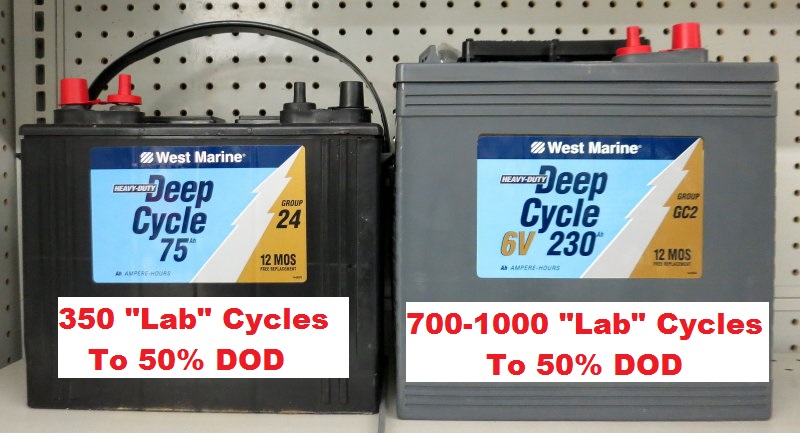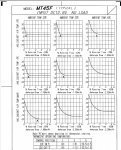vomhorizon
Active member
Thanks for all the help and advise guys. I'm new to solar and have mostly ever camped with ice boxes (or worst) so all this is new to me.
In my case, If I'm on the road for 3-4 hours a day while running the fridge from the alternator and also providing a supplement from the trickle charge coming from the solar controller (I can accommodate both a 100 Watt and a 160 Watt panel given the current space I have on the roof rack) while also getting a few hours of stationary solar ONLY charge in, how much will I be cycling? [ knowing that once I'm done with most of my outdoor camping needs with a lithium pack,I could always disconnect the fridge from the battery and connect it to the lithium unit for the 8-9 hours of no or little sunlight].
If I assume 6-8 or so hours of fridge usage w/o alternator or solar, how much will my battery be depleted before solar panels start back on and before I hit the road? I'm assuming that 3-4 hours of driving plus any solar input coming from the charge controller should be adequate to top up the battery assuming its fairly topped up when I shut off my car and assuming a 3.5 Amp draw (hypothetically speaking because it factors say one or two camp lights being used for say an hour of when we're cooking etc) with a 50% duty cycle for the 6 - 8 hours (that's roughly 12-15 Amps of stationary draw in 24-hours of usage which a 100 or 160 Watt solar panel should be able to put back into the battery throughout the day).
I think I need to figure out whether:
A) Connecting the Victron solar controller and solar panels directly to the starter battery is OK from a battery and car electrical system health perspective (I'm new to this so am still wondering what the net impact of two regulated chargers working concurrently will have). Last thing I want to do is muck up car electrics and void the warranty.
I see most folks running solar setups with the auxillary battery that is being charged by a DC to DC system with a built in solar regulator (like a red arc) or solar charge controller being separate. I know a few who take a solar briefcase and clamp it to the starter battery when stationary but in that case only one system is charging the battery at a time (alternator when engine is on, and solar when engine is off and solar is connected).
B) Can I wire my solar + and - input (coming from the panels down to the solar charge controller) via an anderson plug so that I disconnect it when driving and plug it in when I camp? I guess I need to understand whether it is safe and OK to disconnect monocrystalline (both + and ground terminals) panels form the charge controller and just leave them on the roof like that.
If possible, this would be like taking a solar blanket or briefcase but not having to lug it around in the trunk or set it up when camped. I also really like the idea of trickle charging the battery via solar when I'm parked outside (my work parking is outdoors) as this should basically take care of topping off the AGM (given the charge profile relative to what the Toyota alternator) and saving me the hassle of plugging it into an AC charger every now and then. This will probably be even more important when I upgrade to a group 27.
My reason for avoiding a dual battery system has to do with cost, weight and all the wiring that I'd have to do (I guess you could always get it done via pre assembled kits but those are even more expensive). For the price of the Red Arc DC to DC, I can pretty much buy my entire solar set up (160 Watt panel, 10 AWG wires, and MPPT) and even if I have a dual battery system, I would kind of still need a portable Lithium system because of away-from-car power needs (so I can't really save money by avoiding it) and other general purpose usage around the house or when camping with others.
For sure any battery used for deep cycling (as opposed to dedicated to Starting only)
should be from a known - good maker and a model designed for longevity in true deep cycling usage.
Odyssey's PC-2150 is such, very rare in that it truly lives up in reality to the "dual use" label.
That's G31 size, they likely have others in that line.
In my case, If I'm on the road for 3-4 hours a day while running the fridge from the alternator and also providing a supplement from the trickle charge coming from the solar controller (I can accommodate both a 100 Watt and a 160 Watt panel given the current space I have on the roof rack) while also getting a few hours of stationary solar ONLY charge in, how much will I be cycling? [ knowing that once I'm done with most of my outdoor camping needs with a lithium pack,I could always disconnect the fridge from the battery and connect it to the lithium unit for the 8-9 hours of no or little sunlight].
If I assume 6-8 or so hours of fridge usage w/o alternator or solar, how much will my battery be depleted before solar panels start back on and before I hit the road? I'm assuming that 3-4 hours of driving plus any solar input coming from the charge controller should be adequate to top up the battery assuming its fairly topped up when I shut off my car and assuming a 3.5 Amp draw (hypothetically speaking because it factors say one or two camp lights being used for say an hour of when we're cooking etc) with a 50% duty cycle for the 6 - 8 hours (that's roughly 12-15 Amps of stationary draw in 24-hours of usage which a 100 or 160 Watt solar panel should be able to put back into the battery throughout the day).
I think I need to figure out whether:
A) Connecting the Victron solar controller and solar panels directly to the starter battery is OK from a battery and car electrical system health perspective (I'm new to this so am still wondering what the net impact of two regulated chargers working concurrently will have). Last thing I want to do is muck up car electrics and void the warranty.
I see most folks running solar setups with the auxillary battery that is being charged by a DC to DC system with a built in solar regulator (like a red arc) or solar charge controller being separate. I know a few who take a solar briefcase and clamp it to the starter battery when stationary but in that case only one system is charging the battery at a time (alternator when engine is on, and solar when engine is off and solar is connected).
B) Can I wire my solar + and - input (coming from the panels down to the solar charge controller) via an anderson plug so that I disconnect it when driving and plug it in when I camp? I guess I need to understand whether it is safe and OK to disconnect monocrystalline (both + and ground terminals) panels form the charge controller and just leave them on the roof like that.
If possible, this would be like taking a solar blanket or briefcase but not having to lug it around in the trunk or set it up when camped. I also really like the idea of trickle charging the battery via solar when I'm parked outside (my work parking is outdoors) as this should basically take care of topping off the AGM (given the charge profile relative to what the Toyota alternator) and saving me the hassle of plugging it into an AC charger every now and then. This will probably be even more important when I upgrade to a group 27.
My reason for avoiding a dual battery system has to do with cost, weight and all the wiring that I'd have to do (I guess you could always get it done via pre assembled kits but those are even more expensive). For the price of the Red Arc DC to DC, I can pretty much buy my entire solar set up (160 Watt panel, 10 AWG wires, and MPPT) and even if I have a dual battery system, I would kind of still need a portable Lithium system because of away-from-car power needs (so I can't really save money by avoiding it) and other general purpose usage around the house or when camping with others.
Last edited:



